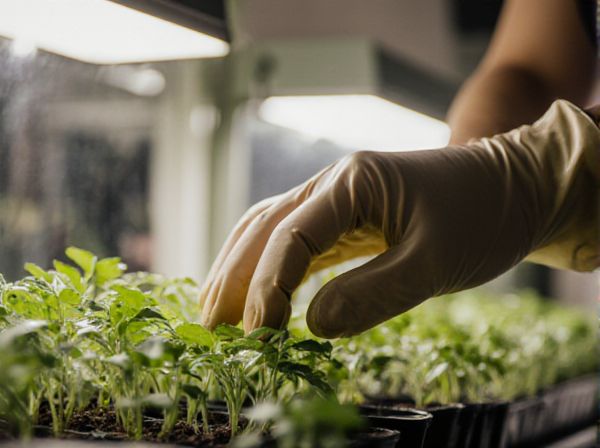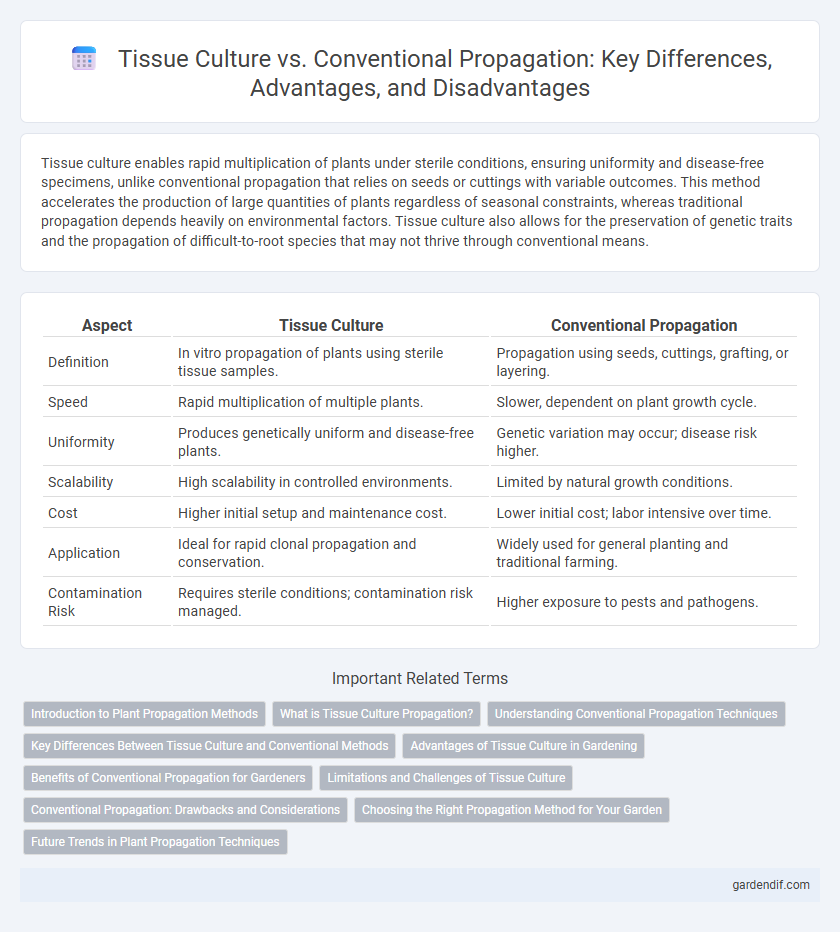
Tissue Culture vs Conventional Propagation Illustration
Tissue culture enables rapid multiplication of plants under sterile conditions, ensuring uniformity and disease-free specimens, unlike conventional propagation that relies on seeds or cuttings with variable outcomes. This method accelerates the production of large quantities of plants regardless of seasonal constraints, whereas traditional propagation depends heavily on environmental factors. Tissue culture also allows for the preservation of genetic traits and the propagation of difficult-to-root species that may not thrive through conventional means.
Table of Comparison
| Aspect | Tissue Culture | Conventional Propagation |
|---|---|---|
| Definition | In vitro propagation of plants using sterile tissue samples. | Propagation using seeds, cuttings, grafting, or layering. |
| Speed | Rapid multiplication of multiple plants. | Slower, dependent on plant growth cycle. |
| Uniformity | Produces genetically uniform and disease-free plants. | Genetic variation may occur; disease risk higher. |
| Scalability | High scalability in controlled environments. | Limited by natural growth conditions. |
| Cost | Higher initial setup and maintenance cost. | Lower initial cost; labor intensive over time. |
| Application | Ideal for rapid clonal propagation and conservation. | Widely used for general planting and traditional farming. |
| Contamination Risk | Requires sterile conditions; contamination risk managed. | Higher exposure to pests and pathogens. |
Introduction to Plant Propagation Methods
Tissue culture enables rapid, large-scale production of genetically identical plants through micropropagation under sterile conditions, ensuring disease-free and uniform crop quality. Conventional propagation methods, such as seed sowing, cuttings, grafting, and layering, rely on natural or manual techniques with slower multiplication rates and greater genetic variability. The choice between tissue culture and conventional propagation depends on factors like scale, plant species, desired uniformity, and resource availability.
What is Tissue Culture Propagation?
Tissue culture propagation is a sterile laboratory technique that involves growing plant cells, tissues, or organs on nutrient media under controlled environmental conditions to produce clones of a desired plant. This method enables rapid multiplication of disease-free and genetically uniform plants, ensuring consistency and high yield. Unlike conventional propagation, which relies on seeds, cuttings, or grafting, tissue culture can produce thousands of plants from a single explant in a shorter time frame.
Understanding Conventional Propagation Techniques
Conventional propagation techniques encompass methods such as seed sowing, cuttings, layering, grafting, and division, relying on natural plant growth processes to produce new plants. These techniques are widely used due to their simplicity, low cost, and ability to maintain genetic variation within crops. Understanding the specific requirements for each method, including timing, environmental conditions, and plant species compatibility, is essential for maximizing propagation success rates.
Key Differences Between Tissue Culture and Conventional Methods
Tissue culture enables rapid, large-scale production of genetically uniform plants through sterile, controlled laboratory conditions, minimizing disease risk and ensuring consistent quality. Conventional propagation relies on seeds, cuttings, or grafting, which may result in genetic variability and slower multiplication rates due to environmental factors. Tissue culture's micropropagation technique offers faster multiplication and precise disease control, while conventional methods are simpler and cost-effective but less efficient for mass production.
Advantages of Tissue Culture in Gardening
Tissue culture offers rapid multiplication of disease-free plants with uniform genetic characteristics, ensuring high-quality propagation in gardening. This technique allows year-round production, independent of seasonal constraints, significantly increasing plant availability and consistency. Moreover, tissue culture reduces the risk of pests and diseases compared to conventional propagation methods such as cuttings or seeds.
Benefits of Conventional Propagation for Gardeners
Conventional propagation offers gardeners the benefits of simplicity, cost-effectiveness, and the ability to use readily available plant materials such as cuttings, seeds, and division. This method supports genetic diversity and adaptability, promoting resilient plant growth in a variety of garden environments. It also requires less specialized equipment and technical knowledge compared to tissue culture, making it accessible for home gardeners and hobbyists.
Limitations and Challenges of Tissue Culture
Tissue culture propagation faces limitations such as high initial setup costs, stringent sterile conditions, and technical expertise requirements, which can impede large-scale adoption. Contamination risks and somaclonal variations pose challenges to maintaining genetic uniformity and plant health. Despite its rapid multiplication potential, tissue culture often struggles with acclimatization and transplant shock when moving plantlets to field conditions.
Conventional Propagation: Drawbacks and Considerations
Conventional propagation methods such as seed sowing, cuttings, and grafting often face limitations including slower multiplication rates and variable offspring quality. These techniques typically require more space, longer growth periods, and are susceptible to pests and diseases, increasing production risks. Moreover, genetic variability in conventional propagation can lead to inconsistent crop yields and characteristics, making it less reliable for large-scale commercial production compared to tissue culture.
Choosing the Right Propagation Method for Your Garden
Tissue culture offers disease-free, uniform plants with rapid multiplication, ideal for large-scale production and rare species conservation. Conventional propagation methods like seed sowing or cuttings are cost-effective, simple, and better suited for gardeners seeking natural variation and slower growth. Selecting the right propagation technique depends on your garden's goals, resource availability, and desired plant traits.
Future Trends in Plant Propagation Techniques
Tissue culture is poised to revolutionize plant propagation by enabling mass production of disease-free, genetically uniform plants with faster turnaround times compared to conventional methods such as seed sowing and cuttings. Emerging trends include automation and AI integration in micropropagation, enhancing scalability and precision in plant tissue growth. Additionally, advances in synthetic biology and CRISPR gene editing promise to create customized plants with improved traits, accelerating future propagation efficiency and sustainability.
Tissue Culture vs Conventional Propagation Infographic

 gardendif.com
gardendif.com